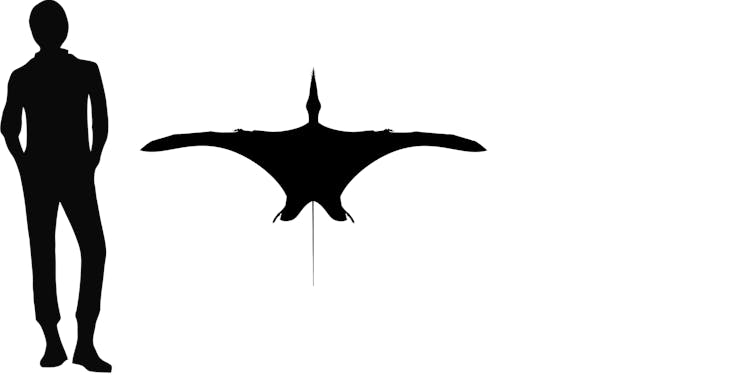


In 2010 paleontologists Brian Andres, James Clark, and Xu Xing described a new pterosaur, Sericipterus wucaiwanensis, from rocks of the Upper Jurassic Shishugou Formation of Xinjiang, China. The name uses the Latin word “sericum” meaning “silk,” a reference to the Silk Road, the ancient overland trade route between Asia and Europe, which once passed through what is now Xinjiang in northwestern China.
The specimen is incomplete and disarticulated, but preserves the majority of the skull, many vertebrae from the neck and torso, and most of the shoulders and wings. The skull is roughly triangular in profile, with a rounded muzzle. There appears to be a low, midline crest on the top of the skull, but its size and shape cannot be determined. The teeth are long and conical, and are directed down and forward. They are widely spaced and appear to increase in length near the tips of the jaws. Overall the skull is quite robust, and would have been about 21 cm (8 inches) long when complete.
The remainder of the skeleton is quite similar to other rhamphorhynchids like Rhamphorhynchus and Scaphognathus. Although the tail was not preserved, it is assumed that Sericipterus would have had a long, somewhat stiff tail like its close relatives. It was one of the largest Jurassic pterosaurs, with an estimated wingspan of about 175 cm (5 ft 9 in), about the same size as a great blue heron.
Andres, Clark, and Xu performed a phylogenetic analysis and found that Sericipterus was a rhamphorhynchid, a common family of long-tailed pterosaurs that lived as aerial fishers. The closest relatives of Sericipterus were found to be Angustinaripterus from the Middle Jurassic Dashanpu Formation of Sichuan, China and Harpactognathus from the Upper Jurassic Morrison Formation of Wyoming, USA. All three species have remarkably robust skulls with rounded muzzles and long procumbant teeth.
Sericipterus lived in a forested floodplain, with a temperate climate. At the time, about 160 million years ago, India was still attached to the southeastern coast of Africa. Because of that, Xinjiang was on the northern coast of the Tethys Ocean, the ancient precursor to Indian Ocean. The large rivers served as a fishing ground for this large pterosaur.
